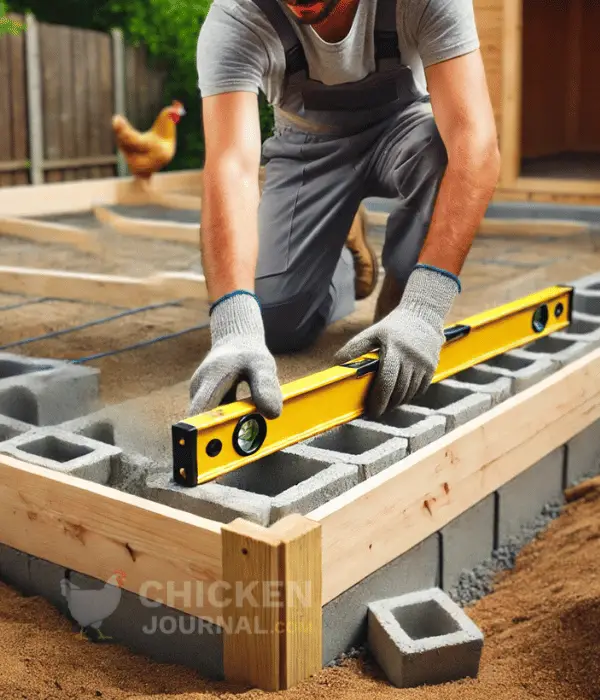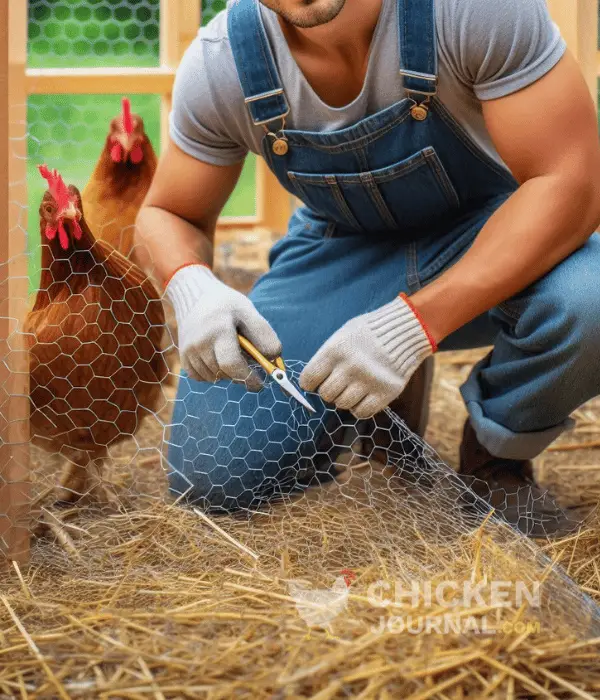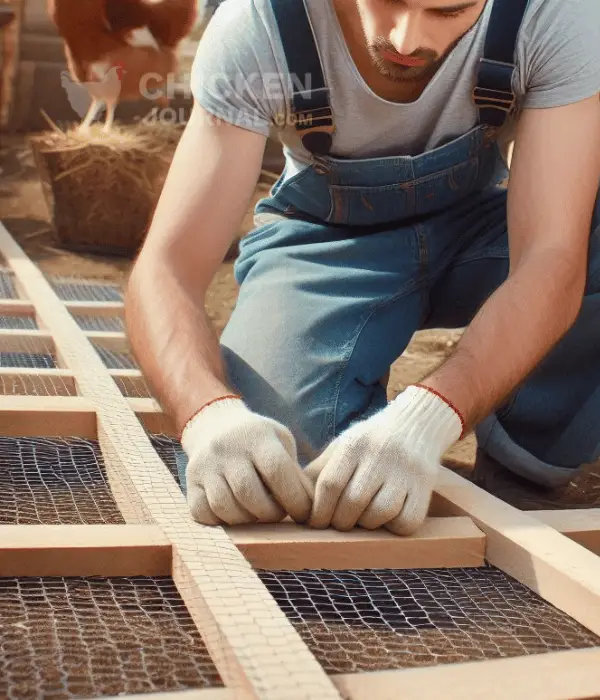Are you searching for a $200 chicken coop building plan?
Do you want to build a chicken coop with a $200 budget at home?
If you want to save money in building a budget-friendly chicken coop, these plans will significantly help you.
Your perfect chicken house costs around $200 and is comfortable and safe, which means innovative design. We will show you how to build it step by step.
This definitive guide will help new and experienced chicken farmers save money in coop building.
Essential Materials and Cost Breakdown For $200 Chicken Coop Building
Building Materials List
Your chicken coop worth $200 must have these essential materials in the first place, according to the producers’ planning.
You will need pressure-treated lumber to create the base frame, plywood sheets for the walls and roofing, and hardware cloth for secure ventilation.
Above all, the assembling and security parts cannot be forgotten. You have to shop for screws, hinges, and latches.
The essential element structure is as follows:
2×4 pressure-treated lumber (6-8 pieces)
- Effective Pressure Treatment – Protects against decay…
Last update on 2025-10-11 / Affiliate links / Images from Amazon Product Advertising API
1/2 inch plywood sheets (4-5 pieces)
- [Good Quality]: Wood performance is stable, not easy to…
- [Flat and Smooth Surface]: After repeated polishing,…
- [Neatly Cut]: The cut of the plate is neat and…
- [Clear Texture]: The texture is natural, clear,…
- [Dimension]: The size of craft plywood sheet is 12×12…
Last update on 2025-10-11 / Affiliate links / Images from Amazon Product Advertising API
Hardware cloth (25 ft roll)
- Half inch hardware cloth, ideal for snake fence,…
- The holes are only 1/2 inch to keep critters out and…
- It’s galvanized and very rust proof. Galvanizing after…
- Use this to protect vegetables and flower roots, bulbs,…
- Use this material to line the bottom of your chain link…
Last update on 2025-10-11 / Affiliate links / Images from Amazon Product Advertising API
Roofing shingles or plastic roofing
- Reliable to Cover: the polycarbonate greenhouse panels…
- Cuttable to Meet Needs: greenhouse replacement panels…
- Cover and Clear: polycarbonate roof panels will cover…
- Protective Layer: Design: polycarbonate greenhouse…
- Wide Usages: polycarbonate greenhouse sheets can not…
Last update on 2025-10-11 / Affiliate links / Images from Amazon Product Advertising API
Built-in door hinges and latches
- Padded self-clamping design of door hinge installation…
- Adjustable settings allow door hinge jig to be used on…
- Cut professional hinge mortises with ¼”, 5/8”, or…
- Unique design of door hinge installation jig eliminates…
- Door hinge installation kit routs hinge mortises for…
Last update on 2025-10-11 / Affiliate links / Images from Amazon Product Advertising API
Galvanized screws and nails
- Various Size: A kit includes six sizes( 2″, 1-1/2″,…
- High-quality Nails: The surface is galvanized, can…
- Convenient Package: Packed in different grids according…
- Use Widely: This set of steel nails can be used for all…
- Noted: It is not recommended to store the nail set in a…
Last update on 2025-10-11 / Affiliate links / Images from Amazon Product Advertising API
Budget Breakdown
To maintain the budget for $200, we will review your financial obligations to understand how much has to be spent on what:
- Wood and plywood $80-100
- Hardware cloth $30-40
- Roofing materials $25-35
- Hardware (hinges, latches, screws) $20-30
- Paint or sealant $15-25
You can save money by checking local hardware stores for materials that are at discount prices or damaged lumber that can still be used.
Most hardware stores have discounted items or leftover pieces at the season’s end.
Sometimes, you can also visit buildings that are being constructed or request materials from your neighbors.
Many additional items would be tools that could help accomplish the goal. For example, a saw, drill, and measuring tape are necessary.
If you do not own these tools, you can borrow them from your friends or local hardware stores to stay within budget.
Also read: DIY vs. Buying a Prefab Chicken Coop: What’s Right for You?
Your $200 Chicken Coop Design Plan
Careful planning of the job before starting to construct the equipment is the only way to obtain a chicken house that is both practical and comfortable for your flock.
An accurately planned design ensures that your chicken coop meets all requirements and stays within your budget.
Space Requirements
Calculate how you allocate the space when working on a chicken coop design.
Each bird should get 2-4 square feet of the chicken house, and the run space should be around 8-10 square feet.
If your flock counts 4 to 6 heads, the farm’s barn should be around 16-24 square feet.
This guarantees adequate utilization of the area and a comfortable atmosphere for the birds to move, rest, and lay among their friends.
Do not forget about the vertical area, too. It should be 6-7 feet at least (the longest point) so that regular cleaning can be done comfortably.
Roosting bars should vary in height to allow chickens to follow their instinct to gain altitude and sleep at their maximum.
Essential Features
The coop’s design must have the following main components for the chickens to be happy and healthy.
Proper ventilation is the first step —include windows or vents near the roof to let hot air escape while preventing cold airflow at the chicken level.
Convenient use of various entrances, such as multiple doors, should be planned. The main entrance door through which the birds come in and out should be the smallest.
The egg-laying places need to be lowered out, the other two doors should be cleaned, and the maintenance job should be done.
Besides, the henhouses should be positioned at an appropriate height for the egg to be collected, one from your stock of 4-5 per kit.
Account for the presence of predators in your overall plan. You can use cloth hardware, key locks on doors, and a solid floor of durable, wire-mesh materials for the central openings to thwart digging predators.
Consider elevating the coop at least 6-12 inches off the ground to protect against moisture and rodents.
Nonetheless, you should implement a covered run area attached to the coop. This sheltered place allows chickens to be outside and play even when it rains, keeping them safe from aerial attacks by predators.
Base Construction of Your $200 Chicken Coop
The foundation significantly affects the chicken coop’s durability and steadiness.
Begin by picking a flat site in your yard with proper drainage. If the area is flat, you can use a shovel and rake to make it even.

Site Preparation
Get rid of all plants, stones, or rubbish on your site. Mark a mild slope away from where the chicken coop will be located to allow proper water drainage.
The place where the chicken coop assembly is made can cause the coop’s wooden parts to start to rot because of the possibility of moisture build-up.
Also read: The best spot to place your chicken coop
Base Materials
Lay down a 4-inch layer of gravel for a secure and sturdy foundation. This provides good drainage and a barrier against predators’ infiltration into the coop.
Place building sand on top of the gravel to create a smooth, pleasant, and flat surface.
Concrete Blocks Placement
Pair concrete blocks at each corner and 4-foot intervals along the perimeter to construct a sturdy foundation.
Use a level tool to fix each block perfectly flat. The elevated design will allow enough checking on the water drainage system, preventing moisture.
By doing this, you will have good ventilation, improving air circulation, which will slowly cause moisture-related problems.
Support Beam Installation
Connect some pressure-treated 2×4 across the concrete blocks to create a strong frame.
Connect these support beams with galvanized brackets and screws so that there can be no rust.
This unique framework will support the total weight of all the structures of your coop.
Flooring Framework
Form a grid pattern of extra 2x4s spaced 16 inches apart. This provides robust support for the plywood flooring while reducing material costs.
Be sure that all joints are fastened securely with the exterior screws so that they will hold fast as expected.
Building the Main Structure of Your $200 Chicken Coop

The chicken coop layout starts with organizing the frame. Place the 2x4s in rectangular form and ensure that all corners are 90-degree squared using a ‘carpenter’s level.’
After firmly placing the wooden frame, connect the sides of the frame using the galvanized screws. Then, one can be sure there are sunshades and very windy areas.
Setting Up the Frame
The first step in constructing the floor is to install floor joists every 16 inches across the foundation.
With this chosen spacing, support for the plywood flooring will be adequate, and material costs will remain low.
The deck screws go through the rim joists on both ends of each joist, securing them to their places.
The order of framing the wall, one at a time and starting from the back wall, should be followed.
Ensure that each wall is plumb (perfectly vertical) before cementing it into the base frame. Use clever temporary braces to hold walls, but you work.
Line two or more walls together by the corners with 3-inch screws at an angle to gain maximum strength.
Adding the Roof Structure
Fix rafters for a roof structure, setting them 24 inches apart. This minimizes the cost of lumber while providing adequate support.
For more safety, cut off the bird’s mouth joints at each end of the rafter where they interconnect with the wall top plates.
This includes coupling collar ties between opposite rafters to resist the load spreading on the roof. These should be positioned about one-third down from the peak.
Sub-fence the roof frame with plywood sheets, starting from the bottom side and working towards the ridge.
Apply the metal roofing panels over a layer of roofing felt for the best protection against rain.
Anyway, the overlapping distance of the panels must be at least one corrugation, then fix them with roofing screws and rubber washers that prevent leaks.
Placing the correct size of the eaves is a key factor in draining water away from the walls.
Consider also the need for ventilation gaps under the eaves and at the ridge in conjunction with the doors and the windows.
Proper airflow is vital for the chickens’ health, but it also lowers the possibility of moisture corroding the coop structure.
Installing Essential Features
The secret weapon behind your chicken coop’s victory is the perfect installation of the necessities for your chickens and their safety.
Let us find out how critical these elements can be in modifying the basic structure into a functioning home for your chickens.
Nesting Boxes and Roosting Bars
Creating a peaceful and comfortable place for the bird to lay its eggs is the most important step in ensuring your flock’s contentment and high productivity.
To build an inexpensive nesting area, put nesting boxes 12 inches off the ground using recycled wooden crates or small storage containers.
Choose a box for every 4-5 hens, making each box about 12x12x12 inches.
With the help of stable 2×4 wood, fix bars for chickens to roost 18-24 inches above the ground, with the wider side touching the top.
By doing so, they can hang on better, protecting their feet from getting wet and cold in a rainy, snowy season.
Put multiple roosts 12 inches apart horizontally and place them at different heights so that those on higher roosts do not poop on birds on lower roosts.
Ventilation and Access Points
Proper airflow is essential for avoiding moisture absorption and mitigating pollutants in the air.
Place the adjustable vents along the top edge of the wall and cover them with the hardware cloth to keep predators away. Set vents on opposite walls to create cross-ventilation.
Your plan should include at least two entrances – a chicken entrance and a cleaning/egg collection entrance.
The chicken portion should be 12×14 inches and at least 6 inches above the ground. The human access point should be big enough to comfortably reach all parts of the coop.
Include a tiny window with a hardware cloth cover to allow airflow and sunlight. Place it where the morning sun can touch your flock, but leave out direct afternoon exposure, which will make your poultry house too hot.
Secure latches must be placed on all the doors and access points. They are attached to simple barrel bolts that also work well and are budget-friendly. However, they do not have to be clever enough to operate by intelligent predators.
Making Your $200 Chicken Coop Predator-Proof

Protecting your chickens from predators is important to keeping them safe and secure. With good coop construction and proper measures to protect them, you may have a successful flock rather than a disaster waiting to happen.
Hardware Cloth vs. Chicken Wire
The best thing you can do to withhold predators from your chickens is to use hardware cloth.
Even though chicken wire appears to be the economical option, it is not strong enough to keep persistent predators at bay. Use 1/2 inch hardware cloth in all the openings, windows, and run areas.
Ensure the installation is strong with heavy-duty staples and overlap the edges to leave gaps.
Foundation Security
Hardware wire or solid materials placed at least 12 inches deep in the perimeter trench can create a predator-proof foundation.
This will stop such digging predators like foxes and raccoons. Consider using a layer of rocks or bricks at ground level in addition to the hardware cloth or solid materials for further protection.
Predator-Resistant Locks
If you are serious about keeping clever predators outside, a standard latch won’t help. The best option is to install two-step locks or carabiners on all doors and access points.
Among the mammals capable of opening simple locks designed for Raccoons are those requiring opposing thumb movements or dummy manipulation, such as complex locks and gadgets.
Elevated Design
You can also significantly boost predator protection by raising your flock’s coop to at least eight inches off the ground.
Installing these features promotes ventilation and makes it difficult for predators to reach the birds.
Regular Maintenance
You should check the chicken coop each week to see any weak areas. Inspect hardware cloth for openings, locks for broken components, and the joining together of parts of the structure if it is the reason behind a predator taking chickens away.
For the best effect of the rather elaborate preventive measures you have put in place, it fixes each weak link promptly once a week. Just remember to guard it from the danger of the little animals at all costs.
$200 Chicken Coop Run Construction and Integration

The program, i.e., the run, provides outdoor space where chickens can engage in physical activities and natural behaviors, which are crucial to the health and happiness of your flock.
This section will show you how to create a secure run using the $200 coop design.
Secure Fencing Installation
Start by installing sturdy fencing material around the designated run area. The pricier hardware cloth provides far better protection than chicken wire, so it should be installed. For the best result, the fence should be buried 15 cm deep.
Creating Access Points
Yes, Please install the human-sized door for easy access during cleaning and maintenance. We should choose a smaller door for poultry that connects the run to the coop.
Your chickens can move freely between the spaces. However, to keep predators out, make sure all doors have secure locks.
Overhead Protection
Use hardware cloth or strong netting to protect your chickens from overhead attacks.
If you are using the net, you must ensure it is pulled tight and correctly attached so it does not fall, allowing the predator to gain access.
Weather Considerations
Create a structure covering the roof and part of the run to protect it from rain and sun.
Pick a few natural perches on the run that allow the chickens to be exposed to both sun and shade. This will help them manage their body temperature throughout the day.
Ground Preparation
Put in some gravel or sand to give an even surface. This will help maintain the coop and prevent a muddy mess when it rains.
A dust bathing area, which is heavily required for your chickens’ hygiene, can be provided. The area can be filled with fine sand or dirt.
FAQs
What is the average lifespan of a $200 chicken coop?
With proper maintenance and protection from the weather, a $200 DIY chicken coop can last 5-7 years. Regular upkeep, such as wood treatment, fixing chicken wire, and predator-proofing the design, will enhance its longevity. Using weather-resistant materials while constructing the coop will also ensure it survives the test of time.
How many chickens can comfortably live in a basic $200 coop?
You can keep 4-6 chickens comfortably in a $200 chicken coop. Each chicken requires about 2-4 square feet according to their size and 8-10 square feet in run area. Always ensure your chickens have good space to enjoy their living inside and around the coop.
Can I modify the coop design to fit extreme weather conditions?
Yes, it is most important to modify your chicken coop according to the weather conditions of your locality. Proper ventilation, weather resistance, nearby shade, and cooling systems are common things that you must include in your chicken coop.
Can we expand a $200 chicken coop later?
Yes, you can expand a $200 chicken coop later. But it is important if you build a chicken coop according to your flock size and numbers. Later you can extend both the chicken coop and run area. Make sure that the original structure is sturdy enough to support the expansions and use high-quality materials to ensure durability.
How long does it typically take to build a $200 chicken coop?
Building a $200 chicken coop typically takes about 2-3 weekends. The exact time can vary depending on the complex design of the coop, equipment, your skill level, and whether you have any help. Proper planning and having all the necessary materials and tools on hand can make the process smoother and more efficient.
What are the essential maintenance tasks for a DIY chicken coop?
short
Essential maintenance tasks for a DIY chicken coop include regular cleaning, checking for predator-proofing, and ensuring proper ventilation. Clean the coop weekly, inspect for damage, and fix any issues promptly. This keeps your chickens healthy and happy.
Conclusion
Building your chicken coop for $200 is more than just a DIY project; it’s an investment in sustainable living and the welfare of your feathered friends.
This detailed guide will help you build a safe, comfy, and predator-proof chicken coop that meets all your chickens’ needs while you co Technology.
Remember that the foundation of a successful endeavor lies in extensive planning, intelligent sourcing of materials, and taking care of essential functions like good ventilation and rightly secure nesting boxes.
Whether you are thinking of a portable chicken coop or a walk-in one, you can use the aforementioned financial plans and adapt them to your chicken’s primary requirements and the space you have.
Do not let the lack of big budgets stop you from making your chickens’ dream house. With basic hand tools and the detailed stages provided, you are equipped to make your coop functional and durable, which will serve your flock for years.
Let us know where you are in the coop-building process, and join a network of enthusiastic chicken owners who are successful in making their DIY coops!






